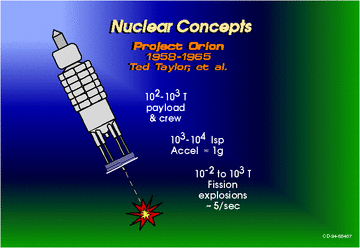
The only real objection to launching an Orion is the concern over radioactive contamination. Lifting an entire city of industrial infrastructure out to deep space would be the most profitable enterprise in all of human history but we must ensure that the environmental impact of such a launch is acceptable and the fallout level as low as possible.
Are you by any chance a Nuclear Phobe???
Fallout can be reduced in a number of ways. Firstly by using high yield thermonuclear pulse units instead of the pure fission devices originally intended back in the early 60's. Relatively low in fission products as fission is only used as a trigger in such modern devices. We get a lot more bang for a lot less fallout. This is thousands of times cleaner. The bigger you build an Orion the more efficiently it runs anyway so big is definately the way to go. With more power available less detonations would be required too. That means far less residual radiation in the form of bomb fragments.
Fallout Calculator(pdf)
Avoiding a groundburst dramatically reduces fallout. This is the primary source of it. Fallout is caused by debris from the ground being sucked into the fireball, irradiated and then spewed out of the top. This radioactive plume coalesces in the atmosphere and then falls back to earth. It's a mix of isotopes of varying half lives. The most vicious of these isotopes have short half lives and are gone in just a few hours. The milder ones can hang around for millennia. Now the blast and heat throw debris outwards. Where does the debris sucked into the fireball come from? The crater scoured in the ground by the energy from the bomb that went into the ground. So fallout is solid material that has become radioactive. Without any such material exposed you can't have fallout. The simple answer to this is to build a very wide launchpad of thick steel coated with graphite. Now there isn't any ground exposed for the dirt to get sucked up into the fireball. Only a very thin layer of graphite will get vapourised which is a lot better than thousands of metric tons of dirt. Remember that hundreds of such groundbursts routinely took place during the 1950's and 1960's creating massive amounts of fallout yet we are still here.
The rest of the detonations are airbursts that don't crater the ground as the first pulses otherwise might have. Doesn't that mean no fallout? That's right, airbursts are relatively clean from a fallout point of view. They do generate some fallout from atmospheric dust and water vapor but not as much as legend holds.
So high levels of fallout can be prevented. Further reduction of fallout might be possible by using an alternative to Plutonium for the brief atmospheric stage. Atleast 80% of the atmosphere lies in the first 16km and it's almost completely gone at around 50km so we can afford to spend a little more on the pulse units used during this short part of the trip. Enriched Uranium would be a cleaner option. An extremely short-lived radioisotope could also be trialled. Something that would decay to a harmless form within days. Expensive to make ofcourse, but only necessary for a tiny fraction of the journey remember. The bomb casing itself now becomes the primary source of fallout. As each successive pulse unit detonates it will irradiate its own shell. So for the atmospheric ascent we make the bomb casings out of something which doesn't readily absorb radiation.
Launching from an extreme polar region which has no life would take care of any immediate threat to organisms within the blast area. Antarctica would be ideal. Nothing lives there.
Only launching one Orion is a simple way of even further reducing fallout. One is all that we need anyway.
It's interesting to note that the primary source of radioactive pollution today comes from coal burning. Both Uranium and Thorium exist in coal beds and neither fallout from weapons testing or emmisions from uranium mine tailings come anywhere close to coal's overall level of radioactive waste. This makes the arguments against an Orion launch seem rather ludicrous.
Contrary to popular belief, radiation is not lethal. No more than oxygen, water, sunshine, caffeine, chilli or a million other things received in moderate doses. There is a misperception about radiation which has been callously perpetuated by ecowacky fearmongers over the years. Many people think that any dose of radiation is bad for them. This is not only untrue but the opposite to the truth. Radiation is essential to life. Without it we cannot grow or maintain our health. Radiation exists all around us and is even produced within the human body. Background Radiation levels make all man made forms of radiation pale by comparison. Only extremely high levels of radiation are dangerous to us and all radiation gradually diffuses into the environment until it is even lower than the natural background level. The gutter science that paints doom and gloom from an Orion launch is nothing more than blatant fear mongering from ill informed if well meaning fools. A controlled liftoff from a remote region that leaves a miniscule amount of residual fallout would have virtually no ill effect on the environment. The rewards in scientific advancement, pioneering exploration, material resource wealth, environmental benefits in terms of new alternative energies and human challenge are priceless.
ProjectOrion.com intro page.
Why build an Orion?
Why launch an Orion?
Orion Links.
Space Message Board.
Project Orion Funding Update!
Project Orion Gallery.